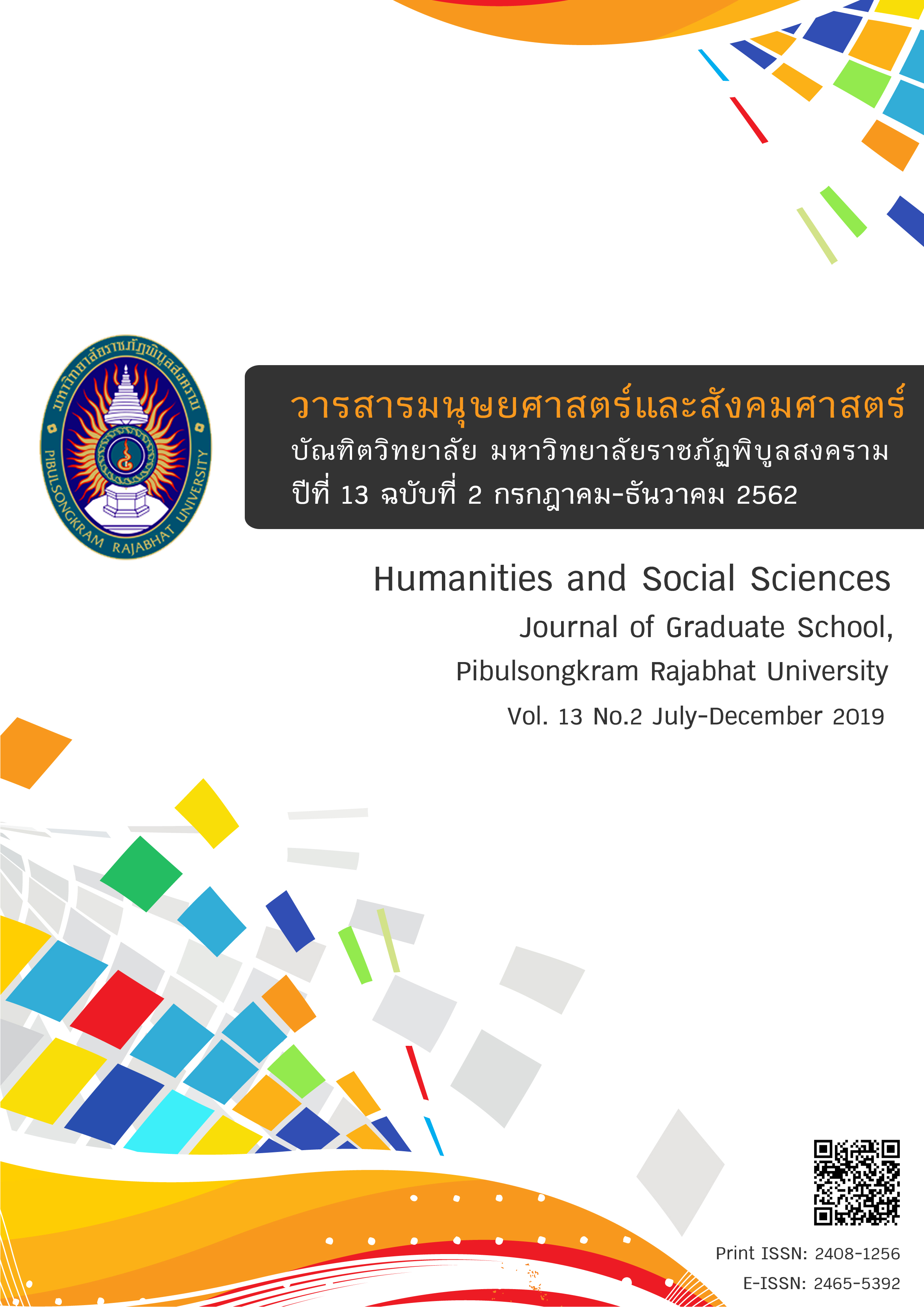The Development of Training Program to Enhance Competency of Using IWB in Instruction of Teachers in Schools under Phitsanulok and Sukhothai Primary Educational Service Area Offices
Keywords:
IWB, training program, competency of using IWBAbstract
The purposes of this research were 1) to study the using of IWB and the need of training program to enhance competency using of IWB in instructional of teachers in schools under Phitsanulok and Sukhothai primary educational service area offices 2) to construct training program 3) to implement training program and 4) to evaluate training program. The instrument used in this research were training program, questionnaire and test. The data was analyzed by mean, S.D., percentage, content analysis, Wilcoxon signed ranks test and effectiveness index. The findings showed that: 1) The results of the use of IWB and the need for training programs found that there were 139 responses with IWB in school (34.75%) and majority of these responses had 1 IWB in school (59.71%) and 126 responses who had IWB which ready to use (90.65%) but only 74 teachers has used IWB in instructional (18.50%) and teachers who used IWB often more than 80% of time in teaching were 2 teachers (2.70%). Most usage patterns were used to write or to draw replaced the regular board (Blackboard or Whiteboard) 68 responses (36.95%). There were 254 teachers (63.50%) who wanted to enhance their competency of using IWB with training programs covering 4 topics: Installation IWB, Basic usage of IWB, Using with other media, and Creating Interactive PowerPoint (IPPT). The most topic needs were Basic using IWB 239 answers (33.90%). 2) The result of construct training program consists of 7 components as follows: (1) Principles of training (2) Training objectives (3) Training managers and trainees (4) Training materials (5) Training content (6) Process of training and (7) Training assessment. The content of the training were 4 units, namely Unit 1 Program installation and board setting, Unit 2 Basic usage of IWB, Unit 3 Use of other media Assembling using the board, and Unit 4 Creating Interactive PowerPoint (IPPT). 3) The results of using the training program found that the mean score of pretest was 17.17, the standard deviation was 4.07 and mean score of posttest was 22.67, the standard deviation was 5.47. Posttest score was higher than Pretest score with statistically significant at the level of 0.05. 4) Evaluation of results obtained from the participants of the training as a whole was at the highest level. The average value was 4.64. The standard deviation was 0.26 and the evaluation of the efficiency index was 42.86.
References
ชฎามาศ ศรีชนะวัฒน์, ไพฑูรย์ พิมดี, และเลิศลักษณ์ กลิ่นหอม. (2558). ปัญหาในการใช้กระดานอัจฉริยะของครูโรงเรียนเซนต์หลุยส์ ฉะเชิงเทรา. วารสารครุศาสตร์อุตสาหกรรม, 14(2), 559-567.
ณัชชา วชิรหัตถพงศ์. (2558). การพัฒนารูปแบบการฝึกอบรมแบบผสมผสานโดยใช้ M-training และการฝึกอบรมแบบเผชิญหน้า เรื่องการใช้กระดานอัจฉริยะ สำหรับครูสังกัดโรงเรียนองค์การบริหารส่วนจังหวัดชลบุรี (วิทยานิพนธ์การศึกษามหาบัณฑิต). มหาวิทยาลัยบูรพา, ชลบุรี.
พัชนี กุลฑานันท์, พิสิฐ เมธาภัทร, ไพโรจน์ สถิรยากร, และมนต์ชัย เทียนทอง. (2554). การพัฒนารูปแบบการฝึกอบรมครูแบบผสมผสานในการทำวิจัยในชั้นเรียน. วารสารมหาวิทยาลัยราชภัฏมหาสารคาม, 5(2), 97-115.
เพ็ญศรี ศรีสวัสดิ์. (2556). การเรียนแบบร่วมมือโดยใช้เทคโนโลยีอินเตอร์แอคทีฟไวท์บอร์ดผ่านเครือข่ายอินเทอร์เน็ต. วารสารการอาชีวะและเทคนิคศึกษา, 3(6), 51-62.
วรรญา สิงห์ทอง, และนงลักษณ์ ใจฉลาด. (2560). การศึกษาสภาพและแนวทางการพัฒนาสมรรถนะครูในสถานศึกษา สังกัดสํานักงานเขตพื้นที่การศึกษาประถมศึกษาสุโขทัย เขต 1. วารสารวิชาการ มหาวิทยาลัยราชภัฏลำปาง, 6(1), 118-128.
วรลักษณ์ คำหว่าง, และนงลักษณ์ ใจฉลาด. (2560). แนวทางพัฒนาทักษะครูในศตวรรษที่ 21 สังกัดสํานักงานเขตพื้นที่การศึกษามัธยมศึกษา ในจังหวัดพิษณุโลก. วารสารวิชาการ มหาวิทยาลัยราชภัฏลำปาง, 6(1), 129-138.
Dudáková, L. (2013). Teaching English Effectively with an Interactive Whiteboard. (Diploma thesis) Faculty of Education Department of English Language and Literature, Charles University in Prague.
Kearney, M., & Schuck, S. (2008). Exploring pedagogy with interactive whiteboards in Australian schools. Australian Educational Computing, 23(1), 8-14.
Manny-Ikan, E., Dagan, O., Tikochinski, T. B. & Zorman, R. (2011). Using the Interactive White Board in Teaching and Learning – An Evaluation of the SMART CLASSROOM Pilot Project. Interdisciplinary Journal of E-Learning and Learning Object, 7, 249-273.
Martin, S. F., Shaw, E. L. Jr., & Daughenbaugh, L. (2014). Using Smart Boards and Manipulative in the Elementary Science Classroom. TechTrends, 58(3), 90-96.
Moss, G., Jewitt, C., Levaaic, R., Armstrong, V., Cardini, A., & Castle, F. (2007). The interactive whiteboards, pedagogy and pupil performance evaluation: An evaluation of schools whiteboard expansion (SWE) project: London challenge. London: School of Educational Foundations and Policy Studies, Institute of Education, University of London.
Patricia, M., (2014). Effectiveness of SMART Board Use in the Teaching and Learning of Statistics. The Electronic Journal of Mathematics and Technology, 8(1), 43-52.
Shenton, A., & Pagett, L. (2007). From ‘bored’ to screen: the use of the interactive whiteboard for literacy in six primary classrooms in England. Literacy, 41(3), 129-136.
Wood, R., & Ashfield J. (2008). The use of the interactive whiteboard for creative teaching and learning in literacy and mathematics: a case study. British Journal of Educational Technology, 39(1), 84-96. doi:10.1111/j.1467-8535.2007.00703.
Downloads
Published
How to Cite
Issue
Section
License
Any articles or comments appearing in the Journal of Humanities and Social Sciences, Rajabhat Phibulsongkram University, are the intellectual property of the authors, and do not necessarily reflect the views of the editorial board. Published articles are copyrighted by the Journal of Humanities and Social Sciences, Rajabhat Phibulsongkram University.









